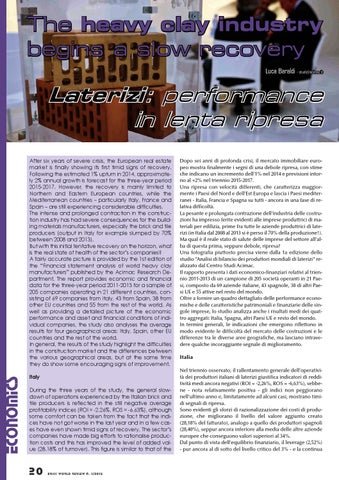The heavy clay industry begins a slow recovery Luca Baraldi - studi@acimac.it
Laterizi: performance in lenta ripresa
economics
After six years of severe crisis, the European real estate market is finally showing its first timid signs of recovery. Following the estimated 1% upturn in 2014, approximately 2% annual growth is forecast for the three-year period 2015-2017. However, the recovery is mainly limited to Northern and Eastern European countries, while the Mediterranean countries – particularly Italy, France and Spain – are still experiencing considerable difficulties. The intense and prolonged contraction in the construction industry has had severe consequences for the building materials manufacturers, especially the brick and tile producers (output in Italy for example slumped by 70% between 2008 and 2013). But with this initial tentative recovery on the horizon, what is the real state of health of the sector’s companies? A fairly accurate picture is provided by the 1st edition of the “Financial statement analysis of world heavy clay manufacturers” published by the Acimac Research Department. The report provides economic and financial data for the three-year period 2011-2013 for a sample of 205 companies operating in 21 different countries, consisting of 69 companies from Italy, 43 from Spain, 38 from other EU countries and 55 from the rest of the world. As well as providing a detailed picture of the economic performance and asset and financial conditions of individual companies, the study also analyses the average results for four geographical areas: Italy, Spain, other EU countries and the rest of the world. In general, the results of the study highlight the difficulties in the construction market and the differences between the various geographical areas, but at the same time they do show some encouraging signs of improvement. Italy During the three years of the study, the general slowdown of operations experienced by the Italian brick and tile producers is reflected in the still negative average profitability indices (ROI = -2.26%, ROS = -6.63%), although some comfort can be taken from the fact that the indices have not got worse in the last year and in a few cases have even shown timid signs of recovery. The sector’s companies have made big efforts to rationalise production costs and this has improved the level of added value (28.18% of turnover). This figure is similar to that of the
20
B RIC K W o rld R eview n. 1/ 2015
Dopo sei anni di profonda crisi, il mercato immobiliare europeo mostra finalmente i segni di una debole ripresa, con stime che indicano un incremento dell’1% nel 2014 e previsioni intorno al +2% nel triennio 2015-2017. Una ripresa con velocità differenti, che caratterizza maggiormente i Paesi del Nord e dell’Est Europa e lascia i Paesi mediterranei - Italia, Francia e Spagna su tutti - ancora in una fase di relativa difficoltà. La pesante e prolungata contrazione dell’industria delle costruzioni ha impresso ferite evidenti alle imprese produttrici di materiali per edilizia, prime fra tutte le aziende produttrici di laterizi (in Italia dal 2008 al 2013 si è perso il 70% della produzione!). Ma qual è il reale stato di salute delle imprese del settore all’alba di questa prima, seppure debole, ripresa? Una fotografia piuttosto precisa viene dalla 1a edizione dello studio “Analisi di bilancio dei produttori mondiali di laterizi” realizzato dal Centro Studi Acimac. Il rapporto presenta i dati economico-finanziari relativi al triennio 2011-2013 di un campione di 205 società operanti in 21 Paesi, composto da 69 aziende italiane, 43 spagnole, 38 di altri Paesi UE e 55 attive nel resto del mondo. Oltre a fornire un quadro dettagliato delle performance economiche e delle caratteristiche patrimoniali e finanziarie delle singole imprese, lo studio analizza anche i risultati medi dei quattro aggregati: Italia, Spagna, altri Paesi UE e resto del mondo. In termini generali, le indicazioni che emergono riflettono in modo evidente le difficoltà del mercato delle costruzioni e le differenze tra le diverse aree geografiche, ma lasciano intravedere qualche incoraggiante segnale di miglioramento. Italia Nel triennio osservato, il rallentamento generale dell’operatività dei produttori italiani di laterizi giustifica indicatori di redditività medi ancora negativi (ROI = -2,26%, ROS = -6,63%), sebbene - nota relativamente positiva - gli indici non peggiorano nell’ultimo anno e, limitatamente ad alcuni casi, mostrano timidi segnali di ripresa. Sono evidenti gli sforzi di razionalizzazione dei costi di produzione, che migliorano il livello del valore aggiunto creato (28,18% del fatturato), analogo a quello dei produttori spagnoli (28,40%), seppur ancora inferiore alla media delle altre aziende europee che conseguono valori superiori al 34%. Dal punto di vista dell’equilibrio finanziario, il leverage (2,52%) - pur ancora al di sotto del livello critico del 3% - e la continua
